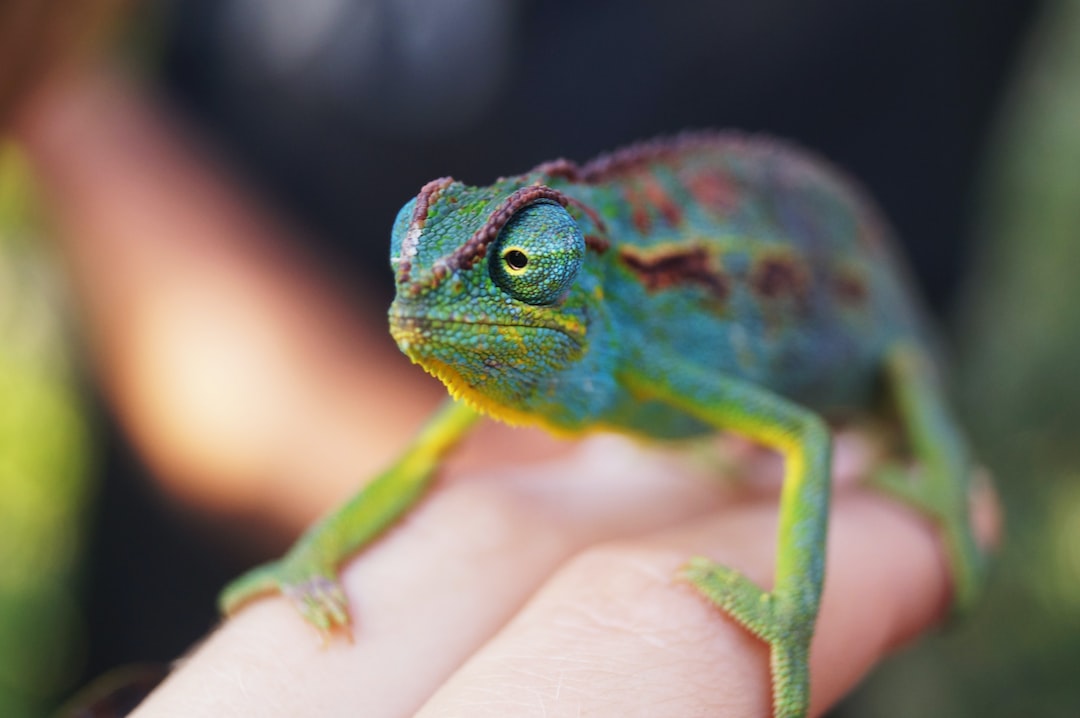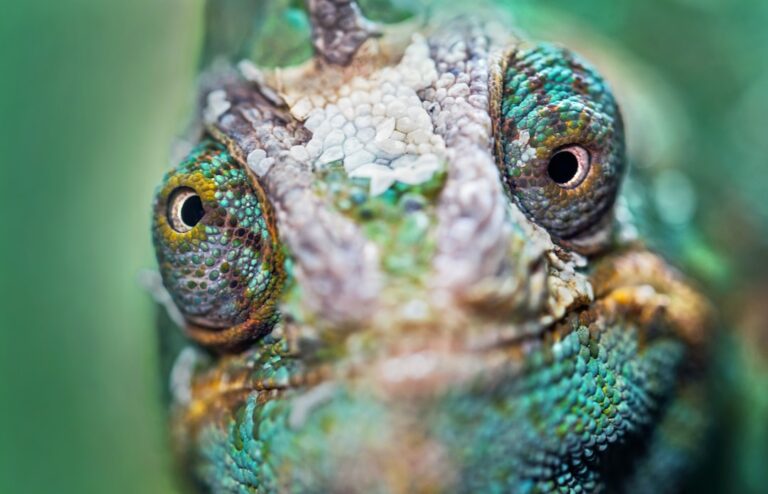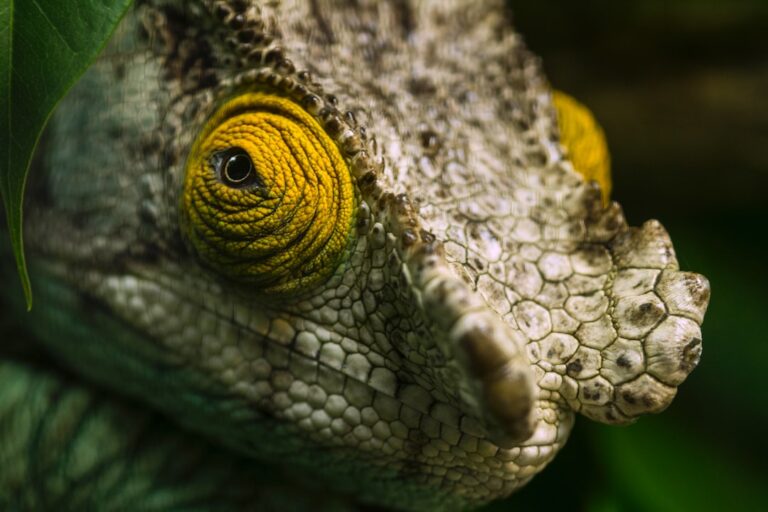Why Do Chameleons Rub Their Eyes?
Chameleons are fascinating creatures known for their ability to change color and blend into their surroundings. They are native to Africa, Madagascar, and parts of Asia, and are highly adapted to their environments. One interesting behavior that chameleons exhibit is eye rubbing. This behavior has puzzled researchers and chameleon enthusiasts for years, as it is not commonly seen in other reptiles.
Eye rubbing in chameleons is a behavior that involves the chameleon rubbing its eyes with its front feet or against a branch or other object. This behavior can be seen in both captive and wild chameleons, and it is believed to serve several purposes. Some researchers believe that eye rubbing helps to clean the chameleon’s eyes, while others suggest that it may be a way for the chameleon to relieve irritation or discomfort.
Table of Contents
The Anatomy of a Chameleon’s Eye
To understand why chameleons rub their eyes, it is important to understand the anatomy of their eyes. Chameleons have large, bulging eyes that can move independently of each other. This allows them to have a 360-degree field of vision and enables them to see in multiple directions at once.
The structure of a chameleon’s eye is quite different from that of a human eye. Chameleons have a specialized lens that allows them to focus on objects both near and far. They also have a cone-shaped retina that contains specialized cells called chromatophores, which are responsible for their ability to change color.
In comparison to human eyes, chameleon eyes are much larger and have a higher density of photoreceptor cells. This gives them excellent vision and allows them to detect even the slightest movement in their environment.
The Importance of Eye Health for Chameleons
Eye health is crucial for chameleons as their eyes play a vital role in their survival. Chameleons rely heavily on their vision to locate prey, identify predators, and navigate their surroundings. Any issues with their eyes can significantly impact their ability to survive in the wild or thrive in captivity.
Eye problems in chameleons can range from minor irritations to more serious conditions that can lead to blindness. Some common eye issues include eye infections, corneal ulcers, and foreign bodies in the eye. These conditions can cause pain, discomfort, and vision impairment for the chameleon.
Common Eye Problems in Chameleons
There are several common eye problems that chameleons may experience. One of the most common issues is eye infections, which can be caused by bacteria, fungi, or parasites. Symptoms of an eye infection may include redness, swelling, discharge, and a cloudy appearance of the eye.
Corneal ulcers are another common issue that chameleons may face. These ulcers are open sores on the surface of the cornea and can be caused by trauma or infection. Symptoms of a corneal ulcer may include redness, tearing, squinting, and a white or gray spot on the cornea.
Foreign bodies in the eye are also a common problem for chameleons. These can include dust, dirt, or small particles that get trapped in the eye. Symptoms of a foreign body in the eye may include excessive blinking, tearing, and rubbing of the eye.
The Role of Eye Rubbing in Chameleon Behavior
Eye rubbing behavior in chameleons can serve as an indicator of underlying issues. While some chameleons may rub their eyes as a normal grooming behavior, excessive or persistent eye rubbing can be a sign of an underlying problem.
Chameleons may rub their eyes to remove debris or irritants that have gotten into their eyes. This can include dust, dirt, or small particles from their environment. By rubbing their eyes, chameleons may be attempting to dislodge these irritants and alleviate any discomfort.
Excessive eye rubbing can also be a sign of an eye infection or injury. Chameleons may rub their eyes in an attempt to relieve pain or discomfort caused by these conditions. If a chameleon is consistently rubbing its eyes or showing other signs of eye problems, it is important to seek veterinary care to determine the underlying cause.
Environmental Factors that Trigger Eye Rubbing in Chameleons
There are several environmental factors that can trigger eye rubbing behavior in chameleons. One common factor is a dry environment. Chameleons require a certain level of humidity to keep their eyes moist and prevent dryness and irritation. If the humidity levels in their enclosure are too low, chameleons may rub their eyes to try to alleviate the dryness.
Another factor that can trigger eye rubbing is poor ventilation in the enclosure. Stagnant air can lead to an accumulation of dust and other irritants, which can cause eye irritation and discomfort for the chameleon. Ensuring proper ventilation in the enclosure can help prevent these issues.
Additionally, bright lights or direct sunlight can also cause eye irritation in chameleons. Chameleons are naturally adapted to live in shaded areas with dappled sunlight, so exposure to intense light for extended periods can be stressful and irritating for their eyes.
Stress and Eye Rubbing in Chameleons
Stress can also contribute to eye rubbing behavior in chameleons. Chameleons are sensitive creatures that can easily become stressed by changes in their environment or handling. When a chameleon is stressed, it may exhibit behaviors such as eye rubbing as a way to cope with the stress.
To reduce stress in chameleons, it is important to provide them with a comfortable and secure environment. This includes providing appropriate hiding spots, maintaining proper temperature and humidity levels, and minimizing disturbances in their enclosure. Regular handling should also be kept to a minimum to avoid causing unnecessary stress.
How to Prevent Eye Problems in Chameleons
Preventing eye problems in chameleons starts with providing them with a healthy and comfortable environment. This includes maintaining proper temperature and humidity levels, providing appropriate lighting, and ensuring good ventilation in their enclosure.
Regular cleaning of the enclosure is also important to prevent the buildup of dust and other irritants. This can be done by regularly removing any debris or waste from the enclosure and wiping down surfaces with a reptile-safe disinfectant.
Regular eye care and monitoring are also crucial for maintaining good eye health in chameleons. This includes checking the eyes for any signs of redness, swelling, discharge, or cloudiness. If any abnormalities are noticed, it is important to seek veterinary care as soon as possible.
When to Seek Veterinary Care for Chameleon Eye Issues
While some minor eye issues can be treated at home, it is important to seek veterinary care for more serious or persistent eye problems in chameleons. A veterinarian who specializes in reptiles will be able to properly diagnose the issue and provide appropriate treatment.
Treatment for eye problems in chameleons may include topical medications, such as antibiotic or antifungal ointments, to treat infections. In some cases, oral medications may be necessary to address underlying issues or systemic infections.
In more severe cases, surgical intervention may be required to remove foreign bodies or repair damage to the eye. It is important to follow the veterinarian’s instructions for treatment and monitor the chameleon closely during the recovery process.
Understanding Chameleon Eye Rubbing and Care
In conclusion, eye rubbing behavior in chameleons can serve as an indicator of underlying issues. It is important to understand the anatomy of a chameleon’s eye and the importance of eye health for their overall well-being. By creating a healthy and comfortable environment, reducing stress, and providing regular eye care, chameleon owners can help prevent eye problems and ensure the long-term health of their pets. If any abnormalities are noticed, it is important to seek veterinary care to properly diagnose and treat the issue. With proper care and attention, chameleons can enjoy healthy eyes and thrive in their environment.
If you’re interested in reptiles, you might also enjoy reading the article “Are Turtles Territorial?” on Reptile Friend. This informative piece explores the territorial behavior of turtles and provides insights into their social interactions. Understanding the territorial nature of turtles can help reptile enthusiasts create suitable habitats and ensure the well-being of their pet turtles. Check out the article here.







